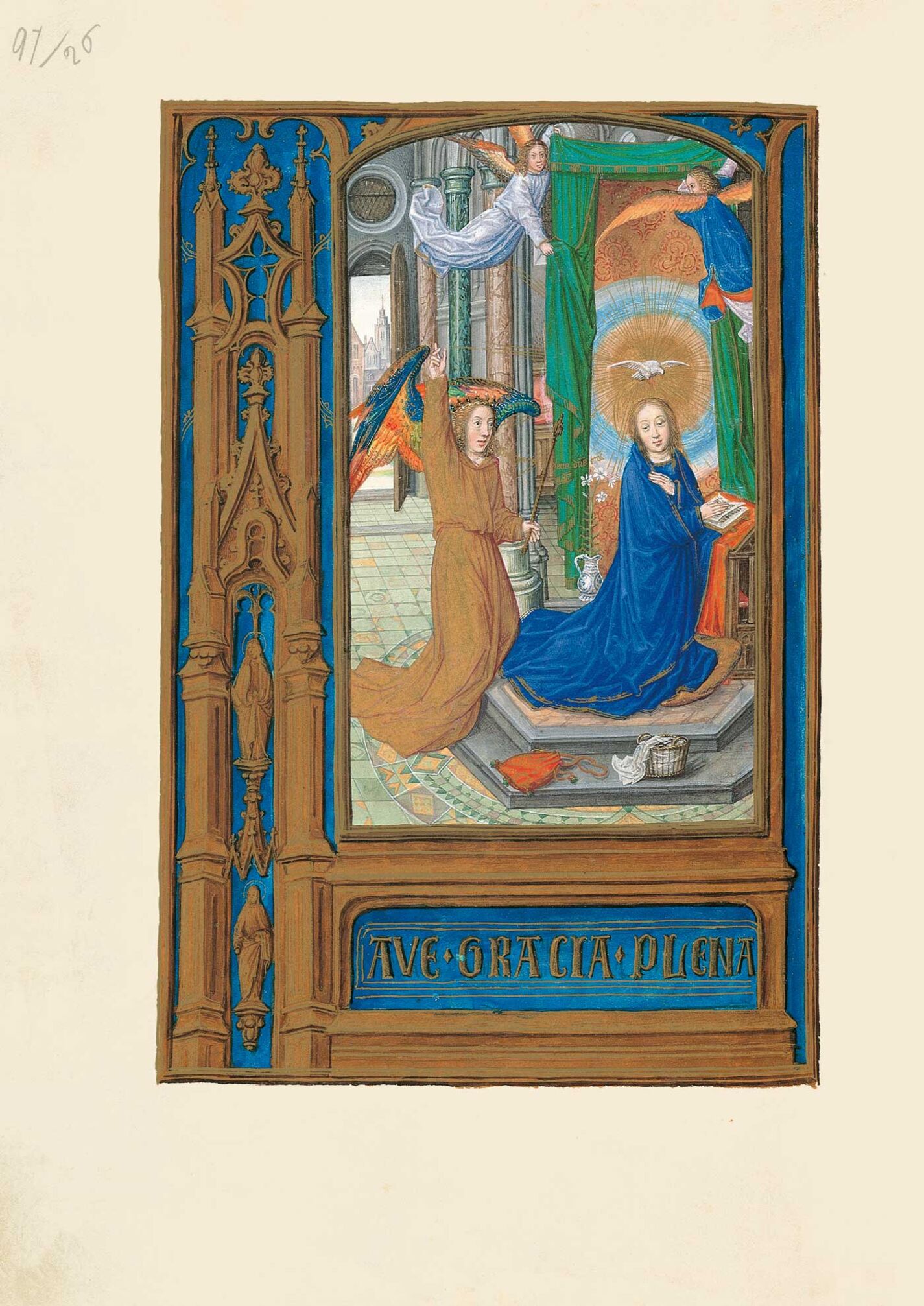The Annunciation is usually the scene that opens the short office of the Virgin and is situated in matins, since the incarnation of Christ is repeated in the invitatory, anthem, antiphon, Psalms and lessons appearing in matins. The setting for the announcement of the Incarnation is a church in keeping with the tradition established by the Master of Boucicaut with three tall columns (the first of a series of references to the Trinity) and compound columns, with another three slender columns in front, surrounding a space that could be interpreted as the choir with three glazed openings symbolising the Christian revelation, and an open door on the left through which the townscape of a typical, Flemish town can be glimpsed albeit, as in the case of the landscapes in the hours of the cross cycle, with a tower reminiscent of the one in Antwerp. Above the door is a stained-glass oculus. The indoor setting depicted like a temple symbolises the Church rising up from the earth with the coming of God in the Annunciation. The archangel Gabriel is depicted with a crown upon his head an attribute appearing previously in Jan van Eyck’s Mellon Annunciation (Washington, National Gallery) as if about to genuflect and addressing Our Lady from behind. The archangel has multicoloured wings and is garbed in a loose, ankle-length gown with a diadem of pearls and precious stones upon his head. His right arm is raised and he points his index finger, an orator’s gesture borrowed from the philosophers of Antiquity, as he expounds God’s message, whilst his left hand grasps a slender staff of command. The golden letters emerging from his mouth spell his greeting to the Virgin, “aue gracia plena d[omi]n[u]s tec[um]”. The Hail Mary was said before the hours of the Virgin themselves: the devout would read Gabriel’s greeting and, with the help of his words, would attain a spiritual intimacy with the Mother of God. The position of the two main characters, i.e. the Virgin garbed entirely in ultramarine blue with gold embroidery around the hems of her cloak and her tunic collar and sleeves and the archangel, is the same position used previously in early-fourteenth-century, Italian art such as Giotto’s Annunciation (1305) on the arch of triumph in the Scrovegni Chapel in Padua. The tender, graceful and beautiful Virgin Mary bears the stamp of mysticism. The table or prie-dieu with a book had already appeared in the Carolingian and Ottoman periods: in literary sources, for example, the Carolingian poem Krist by Otfried describes the Virgin as reading the Psalter when the angel arrived, whilst the Meditationes says that she was reading Isaiah’s prophecy. Our Lady is kneeling in line with the model created by Giotto on a cushion upon a double, hexagonal dais made of stone and marble set on a highly decorative floor made of multicolour tiles. Before her stands a prie-dieu with a book upon it probably a Psalter or book of hours featuring the prophecy in Isaiah 7: 14, according to the Meditationes attributed to Johannes de Caulibus upon which she rests her right hand. Hence the Virgin appears as a model of piety for the spectator and also as a reflection of contemporary devotional practices. Her left hand rests gently on her left shoulder to convey her embarrassment and her head is slightly raised towards the angel with her eyes downcast to emphasise her humility: a quality heightened by her kneeling on a cushion. The Holy Ghost hovers above her in the form of a dove. Its body irradiates a great circle of light like a nimbus around the Virgin’s head. The apparition of the third Person of the Trinity in the Annunciation is known of since the mosaic at Santa Maria la Maggiore in Rome, and it appeared for the first time in medieval art in ninth-century Psalter illustration. To highlight the importance of the scene, two angels hold up a large, green cloth with a lining, resembling a baldachin, which endows the scene with the regal appearance of gold brocade featuring the embroidery of three pomegranates together in yet another allusion to the Trinity and the classical symbol of eternal life. Several items associated with Our Lady’s perpetual virginity can be seen on the dais, such as the blue and white, Italian ceramic jug with a branch of Annunciation lilies and a closed bag, alongside a basket with a white cloth alluding to the making of the veil of the temple. Another symbol of virginity is the round, glass opening above the door. Also worthy of mention are the references to the Trinity in the painting three columns, three windows in the choir, and two juxtaposed hexagons which are related to the conception of Our Lady who was considered, throughout the Middle Ages, to be the temple of the Trinity (templum Trinitatis). The Virgin, who is the home and temple of God, establishes a relationship with the sacred setting the moment she is visited by the archangel and, above all, by the Holy Ghost. The poses of Our Lady and the archangel recall the ones depicted on the wings of the Portinari triptych The adoration of the shepherds attributed to Hugo van der Goes (Florence, Galleria degli Uffizi). The composition is virtually identical to the one in the Rothschild Hours (f. 84v) by Gerard Horenbout.
